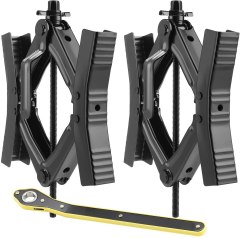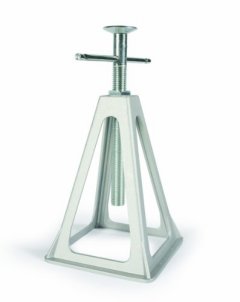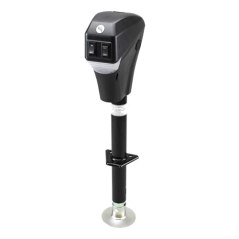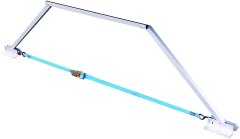BestReviews is reader-supported and may earn an affiliate commission. Details

RV Stabilizer has everything you’ll need to stabilize your camper on any kind of terrain.
RV Stabilizer has everything you’ll need to stabilize your camper on any kind of terrain.
High-quality steel for durability. Ratchet wrench for quick install. Easily adjust by hand. Stabilizer is rust-proof for muddy or wet terrains. Adapter for power drills.
Handle is quite flimsy, so it bends easily.

One of the best RV stabilizer jacks you can buy without spending too much money.
One of the best RV stabilizer jacks you can buy without spending too much money.
Keeps vehicle steady so it doesn't bounce when you walk in it. Swiveling stabilizer pole rotates easily to adjust jack to appropriate height. Supports 6000 pounds.
If used at the full 17-inch extension, it becomes a little wobbly.

This option for stabilizing a trailer RV requires less preparation and setup.
This option for stabilizing a trailer RV requires less preparation and setup.
Lessens the amount of time required to prepare the RV for stabilization. 4 LED lights. Compatible with many different trailer and camper types.
3,500-pound capacity won't work for heavier RVs.

RV stabilizer fits various vehicles and will stop the sway even without extra tools.
RV stabilizer fits various vehicles and will stop the sway even without extra tools.
Deploy in a few minutes without extra tools. Easily adjust legs with push-button. Works with varying frames. Compact and foldable for the added bag.
Ratchet mechanism is quite stiff. Straps are low quality.

Two heavy-duty rust-resistant stabilizers are strong enough to support a high weight.
Two heavy-duty rust-resistant stabilizers are strong enough to support a high weight.
2-pieced stabilizers reduce tension. Heavy-duty steel and zinc for durability. Stabilizers are rust-resistant. Package includes 2 camper jacks. Adjusts between 21-37 inches. Easy to set up.
Footpad is quite small, so you’ll need to mount on larger board for wet ground.

We recommend these products based on an intensive research process that's designed to cut through the noise and find the top products in this space. Guided by experts, we spend hours looking into the factors that matter, to bring you these selections.

Using an RV to travel means not paying for motel rooms, being able to stop whenever and wherever you like, and of course, always having a bathroom available no matter where you are, even at 70 miles per hour on the freeway. To enjoy all the comforts of your RV, especially when you’re off the road, you’ll need an RV stabilizer to keep the RV from rocking back and forth. This is especially true if you have an absorption refrigerator, which must be level when the RV is parked.
Stabilizers sit on the ground under your RV for the sole purpose of keeping it stable. Campers, fifth wheels, travel trailers, and RVs all suffer from swaying and rocking when people walk back and forth in them. The lighter the vehicle, the more noticeable the swaying will be.
Finding the right RV stabilizers means considering the size and weight of your vehicle, as well as the stabilizer design that you find easiest to use. Keep reading, and we’ll help you pick the right one for you.

There are many reasons why you might want your RV to be level when it’s parked. Before you start weighing your options, you have to consider the size of your RV to determine what stabilizers will best suit your vehicle.
The main consideration when it comes to size is the distance from the ground to the support struts under your RV. The higher your RV sits off the ground, the larger the stabilizer you’ll need. Scissors jacks fold down until they’re a few inches high. This makes it easy to store them since they fold up quickly and can be quite compact. On the other hand, it means you’ll have to do more cranking before the stabilizer reaches the bottom of the RV.
To determine the right size for your stabilizers, measure the distance from the ground to the undercarriage of your RV. Subtract an inch or two to take into account the thickness of a pad under the stabilizer, then compare the result to the range of heights for each stabilizer. You should have at least two to three inches between the top of the stabilizer and the bottom of the RV.
Stabilizers aren’t intended to lift an RV to change a tire, but they need to be strong enough to keep it from rocking. This means they will have to support several thousand pounds each. For an RV, the minimum weight limit on a stabilizer should be 5,000 pounds. If the weight limit is less, that stabilizer should only be used on lightweight campers and trailers.

Steel is the best material for stabilizers due to its strength and durability. However, cast aluminum is gaining in popularity for its ability to resist corrosion.
Tripod stabilizer
Tripod stabilizers are the easiest to use — no special tools are required for installation, and they are small enough to store without difficulty. They will prevent side to side movement and bouncing of your RV. While they’re not as adept at stopping front to back bouncing, their simplicity and convenience more than make up for it.
Scissors stabilizer
These stabilizers are excellent at preventing the swaying and bouncing movements of your RV. They readily prevent side-to-side and front-to-back movement for solid stability. They are time-consuming to set up and require more effort than tripod designs.
Scissors stabilizers can be cranked with a power drill if you have an adapter, but you have to be careful if you go that route. It is easy to raise the stabilizer too high and put strain on the frame of your RV.
Telescopic stabilizer
Telescopic stabilizers have to be mounted on the undercarriage of your RV. Some are manually operated, but the more expensive models are electrically driven. The legs descend from the RV once it has been parked and leveled. The manual ones have a hand crank similar to the scissors stabilizers. They can also be cranked with a drill using an adapter.
Fifth wheel stabilizer
A fifth wheel stabilizer supports the tongue of the trailer but won’t be enough by itself. You’ll need to get some other stabilizers for the main body of the trailer.

Once you’ve picked out a stabilizer, there are a few other accessories that will help you keep your home-away-from-home steady.
RV leveler pads: Andersen Hitches Camper Leveler Tuff Pads
These bright red pads from Anderson Hitch are 8 1/4 inches on a side and 3/4 inches thick. They provide a sturdy base for your stabilizers to rest on when you’re using a dirt or gravel parking spot.
Spare crank handle: BAL 20032 Hex Head Crank Handle
You never need a spare crank handle for your stabilizer when you have one on hand. But it’s when you don’t have a spare that your primary crank handle manages to break or disappear. This BAL crank handle won’t cost you much, but it can save you a major headache.
Socket drill adapter: Camco RV Leveling Scissor Jack Socket Drill Adapter
If you want to raise and lower your scissor jack stabilizers with a power drill, you’ll need a socket adapter that fits the head on the stabilizer. This adapter from Camco makes the job quick and easy.
Tire chocks: Camco Tandem Wheel Chock
Always use wheel chocks between your wheels to ensure your RV doesn’t roll or move in either direction before you start putting your stabilizers in place. These bright yellow Camco chocks were designed with RVs in mind.
Low-priced RV stabilizers are available for under $100. The price doesn’t necessarily correlate with quality. These are usually made of cast aluminum and may be fifth wheel stabilizers or scissors stabilizers. Except for fifth wheel stabilizers, these will come in packages of four.
Midrange RV stabilizers cost from $100 to $200 for four stabilizers. These are generally steel construction stabilizers that have rust-resistant coatings on them.
Over $200 is where you will find high-end stabilizers. Most models in this range are electrical telescopic stabilizers. Once mounted under your RV, they can be lowered with the push of a button.

If you didn’t find the right stabilizers for your RV among our top choices, we have a few more recommendations.
The EAZ-LIFT Telescopic RV Stabilizers are made of powder-coated steel to prevent rust, and they adjust from 16 inches up to 30 inches. Each jack will support 6,000 pounds. It's a two-pack, so if you want a stabilizer on all four corners, you'll have to purchase two packages. You will most likely need some grease for the threads.
We also like the EAZ-LIFT Camco Heavy Duty Stabilizers. These come in packages of two and are specifically made to support slide-outs when they're extended, but they can be used anywhere else you'd use ordinary stabilizers. Each one is rated at 5,000 pounds and can extend to 47 inches high. They are made from steel with a rust-resistant coating.

Q. Can stabilizers be used as levelers?
A. This is a common question, and the answer is unfortunately no. Using them that way will put tremendous strain on the frame of the RV, possibly bending it.
Q. Do all RVs need stabilizers?
A. No. Heavy RVs will stabilize themselves on their tires. Small or lightweight RVs do need stabilizers to keep from wobbling as you move around the vehicle.
Q. How long does it take to install the stabilizers each time?
A. With one person, 15 to 20 minutes is the average time, and more hands will make for faster work.
Get emails you’ll love.
Learn about the products you’re wondering if you should buy and get advice on using your latest purchases.
